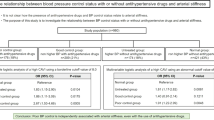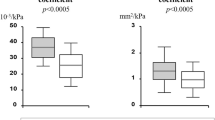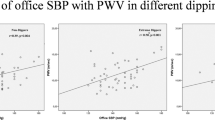Abstract
The present study was performed to compare the long-term effects of 24-h ambulatory blood pressure (BP) control with amlodipine versus valsartan on vascular damage in untreated hypertensive patients. Amlodipine and valsartan have benefits on cardiovascular mortality and morbidity in hypertensive patients. Although ambulatory BP is associated with severity of target-organ damage in hypertensive patients, beneficial effects of ambulatory BP control with amlodipine versus valsartan on vascular damage have not been compared. Pulse wave velocity (PWV), intima–media thickness (IMT) of the carotid arteries, urinary albumin excretion (UAE) and 24-h ambulatory BP were determined in 100 untreated hypertensive patients before and 12 months after the start of antihypertensive therapy with amlodipine or valsartan. Amlodipine and valsartan decreased ambulatory BP similarly, but the variability of 24-h and daytime ambulatory systolic BP was significantly reduced by amlodipine but not by valsartan. The reduced variability of ambulatory systolic BP caused by amlodipine significantly contributed to the improvement of PWV, although both drugs decreased PWV similarly. Carotid IMT was unaffected by treatment with either drug. Valsartan significantly decreased UAE independently of its depressor effect, but amlodipine had no effect on UAE. These results suggest that the 24-h control of ambulatory BP with amlodipine had functionally improved the stiffened arteries of hypertensive patients by the end of 12 months of treatment, in part through reducing BP variability, whereas ambulatory BP control with valsartan decreased the arterial stiffness to the same degree as amlodipine without affecting BP variability maybe through some pleiotropic effects.
This is a preview of subscription content, access via your institution
Access options
Subscribe to this journal
Receive 12 digital issues and online access to articles
$119.00 per year
only $9.92 per issue
Buy this article
- Purchase on Springer Link
- Instant access to full article PDF
Prices may be subject to local taxes which are calculated during checkout


Similar content being viewed by others
References
Julius S, Kjeldsen SE, Weber M, Brunner HR, Ekman S, Hansson L et al. Outocomes in hypertensive patients at high cardiovascular risk treated with regimens based on valsartan or amlodipine: the VALUE randomised trial. Lancet 2004; 363: 2022–2031.
Perloff D, Sokolow M, Cowan R . The prognostic value of ambulatory blood pressures. JAMA 1983; 249: 2792–2798.
Parati G, Pomidossi G, Albini F, Malaspina D, Mancia G . Relationship of 24-h blood pressure mean and variability to severity of target-organ damage in hypertension. J Hypertens 1987; 5: 93–98.
Palatini P, Penzo M, Racioppa A, Zugno E, Guzzardi G, Anaclerio M et al. Clinical relevance of nighttime blood pressure and of daytime blood pressure variability. Arch Intern Med 1992; 152: 1855–1860.
Ohkubo T, Imai Y, Tsuji I, Nagai K, Watanabe N, Minami N et al. Prediction of mortality by ambulatory blood pressure monitoring versus screening blood pressure measurements: a pilot study in Ohasama. J Hypertens 1997; 15: 357–364.
Staessen JA, Thijs L, Fagard R, O’Brien ET, Clement D, de Leeuw PW et al. Predicting cardiovascular risk using conventional vs ambulatory blood pressure in older patients with systolic hypertension. Systolic hypertension in Europe trial investigators. JAMA 1999; 282: 539–546.
Bjorklund K, Lind L, Zethelius B, Andren B, Lithell H . Isolated ambulatory hypertension predicts cardiovascular morbidity in elderly men. Circulation 2003; 107: 1297–1302.
Eguchi K, Kario K, Hoshide Y, Hoshide S, Ishikawa J, Morinari M et al. Comparison of valsartan and amlodipine on ambulatory and morning blood pressure in hypertensive patients. Am J Hypertens 2004; 17: 112–117.
Blacher J, Asmar R, Djane S, London GM, Safar ME . Aortic pulse wave velocity as a marker of cardiovascular risk in hypertensive patients. Hypertension 1999; 33: 1111–1117.
Laurent S, Boutouyrie P, Asmar R, Gautier I, Laloux B, Guize L et al. Aortic stiffness is an independent predictor of all-cause and cardiovascular mortality in hypertensive patients. Hypertension 2001; 37: 1236–1241.
Asmar RG, London GM, O’Rourke ME, Safar ME . Improvement in blood pressure, arterial stiffness and wave reflections with a very-low-dose perindopril/indapamide combination in hypertensive patient. A comparison with atenolol. Hypertension 2001; 38: 922–926.
Boutouyrie P, Tropeano AI, Asmar R, Gautier I, Benetos A, Lacolley P et al. Aortic stiffness is an independent predictor of primary coronary events in hypertensive patients. A longitudinal study. Hypertension 2002; 39: 10–15.
Munakata M, Nagasaki A, Nunokawa T, Sakuma T, Kato H, Yoshinaga K et al. Effects of valsartan and nifedipine coat-core on systemic arterial stiffness in hypertensive patients. Am J Hypertens 2004; 17: 1050–1055.
Niwa Y, Ishimoto K, Kanoh T . Induction of superoxide dismutase in leukocytes by paraquat: correlation with age and possible predictor of longevity. Blood 1990; 76: 835–841.
Ichihara A, Hayashi M, Ryuzaki M, Handa M, Furukawa T, Saruta T . Fluvastatin prevents development of arterial stiffness in hemodialysis patients with type 2 diabetes mellitus. Nephrol Dial Transplant 2002; 17: 1513–1517.
Ichihara A, Hayashi M, Koura Y, Tada Y, Hirota N, Saruta T . Long-term effects of intensive blood-pressure lowering on arterial wall stiffness in hypertensive patients. Am J Hypertens 2003; 16: 959–965.
Ichihara A, Hayashi M, Kaneshiro Y, Takemitsu T, Homma K, Kanno Y et al. Low doses of losartan and trandolapril improve arterial stiffness in hemodialysis patients. Am J Kidney Dis 2005; 45: 866–874.
Ichihara A, Hayashi M, Koura Y, Tada Y, Kaneshiro Y, Saruta T . Long-term effects of statins on arterial pressure and stiffness of hypertensives. J Hum Hypertens 2005; 19: 103–109.
Sun K, Daimon M, Watanabe S, Komuro I, Masuda Y . The relation of pulse wave velocities measured by oscillometric and tonometric methods and clinical application studies. Jpn J Appl Physiol 2002; 32: 81–86.
Yamashina A, Tomiyama H, Takeda K, Tsuda H, Arai T, Hirose K et al. Validity, reproducibility, and clinical significance of noninvasive brachial–ankle pulse wave velocity measurement. Hypertens Res 2002; 25: 359–364.
Pickering TG, James GDJ . Ambulatory blood pressure and prognosis. J Hypertens 1994; 12: S29–S33.
Ichihara A, Kaneshiro Y, Takemitsu T, Sakoda M, Hayashi M . Ambulatory blood pressure variability and brachial–ankle pulse wave velocity in untreated hypertensive patients. J Hum Hypertens 2006 ; 20(7): 529–536.
Kikuya M, Hozawa A, Ohokubo T, Tsuji I, Michimata M, Matsubara M et al. Prognostic significance of blood pressure and heart rate variabilities: the Ohasama study. Hypertension 2000; 36: 901–906.
Imai Y, Aihara A, Ohkubo T, Nagai K, Tsuji I, Minami N et al. Factors that affect blood pressure variability. A community-based study in Ohasama, Japan. Am J Hypertens 1997; 10: 1281–1289.
Navar LG, Inscho EW, Majid DSA, Imig JD, Harrison-Bernard LM, Mitchell KD . Paracrine regulation of the renal microcirculation. Physiol Rev 1996; 76: 425–536.
Pugsley MK . The angiotensin-II (AT-II) receptor blocker olmesartan reduces renal damage in animal models of hypertension and diabetes. Proc West Pharmacol Soc 2005; 48: 35–38.
Yasunari K, Maeda K, Watanabe T, Nakamura M, Yoshikawa J, Asada A . Comparative effects of valsartan versus amlodipine on left ventricular mass and reactive oxygen species formation by monocytes in hypertensive patients with left ventricular hypertrophy. J Am Coll Cardiol 2004; 43: 2116–2123.
Hansson L, Zanchetti A, Carruthers G, Dahlof B, Elmfeldt D, Julius S et al. Effects of intensive blood-pressure lowering and low-dose aspirin in patients with hypertension: principal results of the Hypertension Optimal Treatment (HOT) randomised trial. Lancet 1998; 351: 1755–1762.
Zanchetti A, Bond MG, Hennig M, Neiss A, Mancia G, Dal Palu C et al. Calcium antagonist lacidipine slows down progression of asymptomatic carotid atherosclerosis: principal results of the European Lacidipine Study on Atherosclerosis (ELSA), a randomized, double-blind, long-term trial. Circulation 2002; 106: 2422–2427.
On YK, Kim CH, Oh BH, Lee MM, Park YB . Effects of angiotensin converting enzyme inhibitor and calcium antagonist on endothelial function in patients with essential hypertension. Hypertens Res 2002; 25: 365–371.
Klingbeil AU, John S, Schneider MP, Jacobi J, Handrock R, Schmieder RE . Effect of AT1 receptor blockade on endothelial function in essential hypertension. Am J Hypertens 2003; 16: 123–128.
Mule G, Cottone S, Vadala A, Volpe V, Mezzatesta G, Mongiovi R et al. Relationship between albumin excretion rate and aortic stiffness in untreated essential hypertensive patients. J Intern Med 2004; 256: 22–29.
Williams B, Lacy PS, Thom SM, Cruickshank K, Stanton A, Collier D et al. Differential impact of blood pressure-lowering drugs on central aortic pressure and clinical outcomes: principal results of the Conduit Artery Function Evaluation (CAFE) study. Circulation 2006; 113: 1213–1225.
Acknowledgements
This work was supported in part by grants from the Ministry of Education, Science and Culture of Japan (16790474 and 17390249). We also appreciate the skilful secretarial work of Ms Yukiko Prendergast and Ms Mayumi Shimada.
Author information
Authors and Affiliations
Corresponding author
Rights and permissions
About this article
Cite this article
Ichihara, A., Kaneshiro, Y., Takemitsu, T. et al. Effects of amlodipine and valsartan on vascular damage and ambulatory blood pressure in untreated hypertensive patients. J Hum Hypertens 20, 787–794 (2006). https://doi.org/10.1038/sj.jhh.1002067
Received:
Revised:
Accepted:
Published:
Issue Date:
DOI: https://doi.org/10.1038/sj.jhh.1002067
Keywords
This article is cited by
-
Strategic design and clinical evaluation of a fixed-dose combination tablet comprising valsartan, amlodipine, rosuvastatin and ezetimibe for patients with hypertension and dyslipidemia
Journal of Pharmaceutical Investigation (2024)
-
Effect of Amlodipine/Nebivolol combination therapy on central BP and PWV compared to Amlodipine/Valsartan combination therapy
The Egyptian Heart Journal (2022)
-
Visit-to-visit blood pressure variability, average BP level and carotid arterial stiffness in the elderly: a prospective study
Journal of Human Hypertension (2017)
-
Blood pressure (BP) assessment—from BP level to BP variability
Pediatric Nephrology (2016)
-
The impact of angiotensin receptor blockers on arterial stiffness: a meta-analysis
Hypertension Research (2015)



